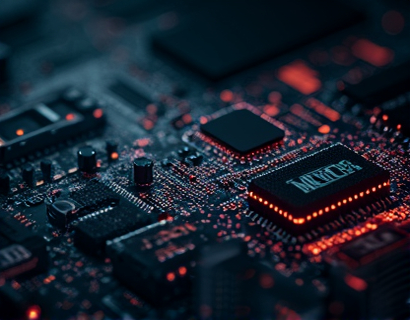Advanced Layer 2 Solutions for EVM: Transforming Blockchain Scalability and Developer Efficiency
In the rapidly evolving landscape of blockchain technology, the Ethereum Virtual Machine (EVM) has been a cornerstone for deploying decentralized applications (dApps). However, as the adoption of blockchain solutions grows, the limitations of the EVM, particularly in terms of scalability and developer efficiency, have become increasingly apparent. Advanced Layer 2 (L2) solutions are emerging as a transformative force, addressing these challenges and paving the way for the next generation of blockchain innovation. This article delves into the intricacies of these L2 solutions, focusing on how they enhance scalability, security, and cost-effectiveness for EVM-enabled software, ultimately revolutionizing the developer experience.
Understanding the Scalability Challenge
The EVM, while powerful, faces significant scalability issues as the number of transactions and smart contracts increases. Each transaction requires a gas fee, and the limited block size and processing capacity of Ethereum's mainnet lead to congestion, high costs, and long confirmation times. These bottlenecks not only hinder user experience but also deter developers from building complex and scalable dApps. To overcome these challenges, Layer 2 solutions have been developed to offload some of the processing and storage requirements from the main blockchain, thereby enhancing overall network performance.
Layer 2 Solutions: An Overview
Layer 2 solutions operate on top of the existing blockchain (Layer 1) to improve transaction throughput and reduce costs. These solutions do not alter the underlying blockchain but instead create a secondary layer that handles a significant portion of the network's activity. Key L2 solutions include state channels, sidechains, and rollups. Each of these approaches has unique mechanisms and benefits, catering to different use cases and requirements.
State Channels
State channels allow multiple parties to conduct a series of transactions off the main blockchain, with the final state being submitted to the EVM once the channel is closed. This method significantly reduces the number of on-chain transactions, lowering gas costs and increasing transaction speed. For example, in a payment application, multiple micropayments can occur off-chain, with only the initial and final states recorded on the blockchain. This approach is particularly effective for applications requiring frequent, low-value transactions.
Sidechains
Sidechains are independent blockchains that are linked to the main EVM through two-way pegs. They allow assets to be transferred between the main chain and the sidechain, enabling different consensus mechanisms and faster transaction processing. Sidechains can be tailored to specific use cases, offering enhanced scalability and flexibility. However, they require careful design to ensure security and interoperability with the main chain.
Rollups
Rollups are one of the most promising L2 solutions, particularly for Ethereum. They come in two main types: Optimistic Rollups and ZK-Rollups. Optimistic Rollups bundle multiple transactions into a single transaction on the main chain, with a challenge period to verify the validity of off-chain transactions. If no challenges are raised, the transaction is confirmed. ZK-Rollups, on the other hand, use zero-knowledge proofs to bundle and verify transactions off-chain, providing faster confirmation times and higher throughput. Both types significantly reduce gas costs and improve transaction speeds, making them ideal for scalable dApps.
Enhancing Developer Efficiency
Beyond scalability, advanced L2 solutions also transform developer efficiency. By offloading heavy computational tasks to the L2 layer, developers can focus on building complex features and user experiences without being bogged down by the limitations of the EVM. This separation of concerns leads to more streamlined development processes and faster deployment times.
Moreover, L2 solutions often provide robust development tools and libraries that simplify the creation of dApps. For instance, frameworks like Optimism and StarkNet offer developers pre-built components and best practices, reducing the learning curve and development time. These tools also facilitate easier testing and debugging, further enhancing the developer experience.
Security Considerations
Security remains a paramount concern in the adoption of Layer 2 solutions. While L2 protocols are designed to be secure, they introduce new vectors of potential attacks. For example, state channels require trust in the parties involved, and sidechains must ensure secure asset transfer mechanisms. Rollups, especially ZK-Rollups, rely on the integrity of the zero-knowledge proofs. To mitigate these risks, rigorous testing, auditing, and community oversight are essential.
Reputable L2 solution providers invest heavily in security research and collaboration with the broader blockchain community. They implement best practices and adhere to industry standards to ensure that their solutions meet the highest security benchmarks. Developers should prioritize working with well-established and transparent L2 providers to minimize security risks.
Cost-Effectiveness and Economic Incentives
The cost savings offered by Layer 2 solutions are a significant driver for their adoption. By reducing the number of on-chain transactions, L2 protocols lower gas fees, making blockchain applications more accessible and affordable. This cost reduction is particularly beneficial for microtransactions and high-frequency use cases, which are often prohibitively expensive on the main chain.
Additionally, L2 solutions can create new economic incentives for network participants. For instance, validators in state channels or rollup networks can earn fees for facilitating transactions, fostering a more decentralized and incentivized network. These economic mechanisms help sustain the L2 layer and encourage broader adoption.
Case Studies and Real-World Applications
The potential of advanced L2 solutions is evident in various real-world applications. Decentralized finance (DeFi) platforms, for example, have leveraged rollups to offer faster and cheaper trading experiences. Gaming platforms have utilized state channels to enable seamless in-game transactions and asset transfers. Non-fungible token (NFT) marketplaces have adopted sidechains to handle high volumes of transactions efficiently.
These case studies demonstrate that L2 solutions are not just theoretical concepts but are being actively implemented to solve real-world problems. As more developers and projects adopt these technologies, the ecosystem continues to mature and expand.
Future Prospects and Challenges
The future of Layer 2 solutions is promising, with ongoing research and development aimed at addressing current limitations and exploring new possibilities. One area of focus is interoperability between different L2 layers and blockchains, enabling a more connected and seamless blockchain ecosystem. Scalability solutions that can work across multiple blockchains will further enhance the versatility and adoption of decentralized applications.
However, challenges remain, including the need for standardized protocols, improved user interfaces, and greater developer education. The blockchain community must continue to collaborate and innovate to overcome these hurdles and fully realize the potential of advanced L2 solutions.
Conclusion
Advanced Layer 2 solutions are revolutionizing blockchain scalability and developer efficiency, offering faster, more secure, and cost-effective decentralized applications. By offloading heavy tasks to secondary layers, these solutions enhance the overall performance of the EVM and pave the way for the next generation of blockchain innovation. As the technology matures and more developers embrace L2 solutions, the future of blockchain looks brighter and more capable than ever.










































